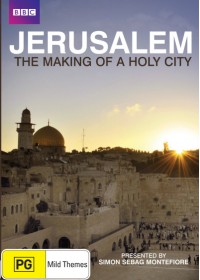Jerusalem: The Making of a Holy City (2011) |
|
Jerusalem: The Making of a Holy City (2011) |
|


|
| BUY IT |
| General | Extras | ||
| Category | Documentary | None | |
| Rating |

|
||
| Year Of Production | 2011 | ||
| Running Time | 177:10 | ||
| RSDL / Flipper | Dual Layered | Cast & Crew | |
| Start Up | Menu | ||
| Region Coding | 4 | Directed By |
Tom Sheahan Karen Selway |
|
Studio
Distributor |
 Roadshow Home Entertainment |
Starring | Simon Sebag Montefiore |
| Case | ? | ||
| RPI | $19.95 | Music | Carl Harms |
| Video | Audio | ||
| Pan & Scan/Full Frame | None |
English Dolby Digital 2.0 English Descriptive Audio |
|
| Widescreen Aspect Ratio | 1.78:1 | ||
| 16x9 Enhancement |
 |
||
| Video Format | 576i (PAL) | ||
| Original Aspect Ratio | 1.78:1 | Miscellaneous | |
| Jacket Pictures | No | ||
| Subtitles | English for the Hearing Impaired | Smoking | No |
| Annoying Product Placement | No | ||
| Action In or After Credits | No | ||
“Jerusalem may well be the best argument against religion there has ever been
Simon Sebag Montefiore
Simon Sebag Montefiore is a historian and author with books on Russian and general history. He is also the author of Jerusalem: The Biography, published early in 2012, and he hosts Jerusalem: The Making of a Holy City, a BBC TV series in three parts tracing the history, traditions and religions of the city from 3200 BC to the present day.
Jerusalem: The Making of a Holy City is mostly Montefiore talking to the camera as he makes his way around modern Jerusalem and its environs looking at the historical remains of the earlier civilizations. There are a few other talking heads, mainly academics, but their contributions are brief, allowing the beauty of the city to be on full view. There is also some archival newsreel footage, especially in Episode 3. Interestingly, there are very few contributions from those involved in religion. But it is not only the monuments, temples and churches that Montefiore views, although they get full exposure in the stunning colour cinematography, but the less salubrious regions of Jerusalem beside the Jewish walls and barbed wire, the slums, bazaars and narrow streets of the city. Montefiore is a knowledgeable and engaging presenter, enthusiastic about his subject, and of course he has the marvellous holy city as a backdrop.
The three episodes are:
Episode One commences with the Canaanites, who settled the site due to its defensible crags and the presence of a sure source of water, so vital in this arid land. Then came the Israelites and their mythical kings David and Solomon, before the Assyrians, Babylonians, the Greeks and Romans took turns at controlling the city. Jesus preached and died in the city, and founded a new religion, the Jews revolted against Rome and were slaughtered and dispersed by Titus and Jerusalem fell into decline until the Emperor Constantine converted to Christianity and revived its fortunes.
Episode Two starts with the Prophet Muhammad, the coming of Islam and the capture of Jerusalem from the Christians. The Umayyad Dynasty rebuilt on the Temple Mound, including the magnificent Dome of the Rock but with the Crusades the city changed hands a number of times including being conquered by Saladin for Islam. In 1229 AD in a little known treaty between Frederick II and a descendant of Saladin, power in Jerusalem was shared between Christian and Moslem. But it didn’t last, and Jerusalem lapsed to its lowest ebb, even being sacked by Tartars from the Crimea.
Jerusalem is saved from obscurity from an unlikely source, Baibars and the Mamluks from Egypt who defeated the Mongols and made the city their religious centre. Two centuries later came the Ottomans, and it is one of their Sultans, Suleiman, who rebuilt the city walls that still exist today. Under the Moslem Ottomans other religions were openly tolerated in Jerusalem and the various Christian sects, mainly the Latins (Catholics), supported by the French, and the Orthodox, supported by the Russians, disputed ascendency in the Churches of Jerusalem. The anti-Jewish pogroms in Tsarist Russia also caused a wave of Jewish immigration, leading to a greater Jewish population in Jerusalem than any time since their dispersed by the Romans.
From the late 1890s the Zionists called for the creation of a Jewish state. After the defeat of the Ottomans in WWI, Palestine become a British Mandate, and increased Jewish immigration led to an Arab uprising that was suppressed by the British. Post WWII, the British left, the state of Israel was created by the UN, and in wars between the Jews and Arabs in 1948 and 1967 Jerusalem was partitioned, a divided city.
Jerusalem: The Making of a Holy City is an entertaining series on an interesting subject. It is presented by Simon Sebag Montefiore, whose grandfather had a hand in creating the first Jewish suburb outside of the city walls of Jerusalem. He is Jewish, but deplores the radicalisation of the city in the name of faith, and presents a balanced account of the city, its history and its religions.
Jerusalem: The Making of a Holy City is presented in an aspect ratio of 1.78:1, which looks to be the original ratio, and is 16x9 enhanced.
This is a nice print. Sharpness, blacks and shadow detail are excellent when it wants to be: there are some sections of deliberate blurriness. Brightness and contrast are consistent while skin tones are natural. Colours are deep and vibrant, beautifully rendering the images of Jerusalem and the surrounding countryside. There is some motion blur with movement in front of broken surfaces such as brickwork, but otherwise marks and artefacts are absent.
White English subtitles for the hearing impaired are available that, from the portion I sampled, follow the narration closely. Subtitles also come on to translate the few sections of non-English interviews.
The layer change was at 30:02 in Episode 3 created a slight pause on my equipment.
A good print, perfectly acceptable for a recent TV series.
| Sharpness | |
| Shadow Detail | |
| Colour | |
| Grain/Pixelization | |
| Film-To-Video Artefacts | |
| Film Artefacts | |
| Overall |
Audio is English Dolby Digital 2.0 surround encoded at 224 Kbps.
The narration is clear and easy to understand. This is basically a talking head documentary but the music by Carl Harms is quite dramatic, and more noticeable than in most TV series especially in the rear speakers, giving a nice feel to the audio presentation. That is not a criticism as the music adds to the visual experience. The sub-woofer is not used.
As this is mostly direct to camera speech, lip synchronisation is not a problem.
The audio is fine for a recent TV series, with better than usual music.
| Dialogue | |
| Audio Sync | |
| Clicks/Pops/Dropouts | |
| Surround Channel Use | |
| Subwoofer | |
| Overall |
Nothing.
NOTE: To view non-R4 releases, your equipment needs to be multi-zone compatible and usually also NTSC compatible.
The Region 2 UK release of Jerusalem: The Making of a Holy City looks to be identical to our Region 4 release. I cannot currently find any listing of a Region 1 US release. Buy local.
Simon Sebag Montefiore, historian and author, presents a BBC TV series in three parts tracing the history, traditions and religions of the city of Jerusalem from 3200 BC to the present day. He is a knowledgeable and engaging presenter. This is an entertaining series on an interesting subject, even handed and well presented.
The DVD comes with good video and audio. No extras.
| Video | |
| Audio | |
| Extras | |
| Plot | |
| Overall |
| Review Equipment | |
| DVD | Sony BDP-S580, using HDMI output |
| Display | LG 55inch HD LCD. This display device has not been calibrated. This display device is 16x9 capable. This display device has a maximum native resolution of 1080p. |
| Audio Decoder | NAD T737. This audio decoder/receiver has not been calibrated. |
| Amplification | NAD T737 |
| Speakers | Studio Acoustics 5.1 |